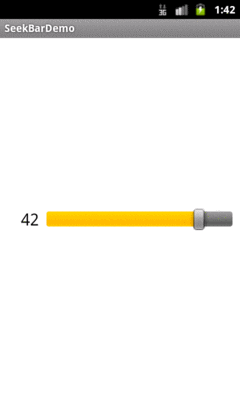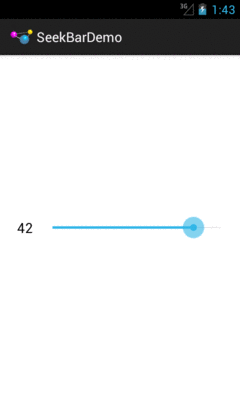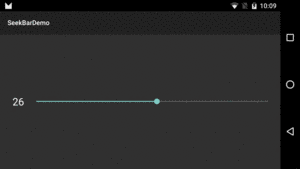
Figure 1070: Android 2.3.3
SeekBar allows the user to choose a value along a continuous range by sliding
a “thumb” along a horizontal line. In effect — and in practice, as it turns out –
SeekBar is a user-modifiable ProgressBar.
The value range of a SeekBar runs from 0 to a developer-set maximum value.
As with ProgressBar, the default maximum is 100, but that can be changed via
an android:max attribute or the setMax() method. The minimum value is always
0, so if you want a range starting elsewhere, just add your starting value to the
actual value (obtained via getProgress()) to slide the range as desired.
You can find out about changes in the SeekBar value by attaching an
OnSeekBarChangeListener implementation. The primary method on that interface
is onProgressChanged(), where you are notified about changes in the progress
value (second parameter) and whether that change was initiated directly by
the user interacting with the widget (third parameter). The interface also
has onStartTrackingTouch() and onStopTrackingTouch(), to indicate when the
user is attempting to change the position of the thumb via the touchscreen,
though these methods are less-commonly used.
The sample project can be found in
WidgetCatalog/SeekBar.
Layout:
<LinearLayout xmlns:android="http://schemas.android.com/apk/res/android"
xmlns:tools="http://schemas.android.com/tools"
android:layout_width="match_parent"
android:layout_height="match_parent"
android:gravity="center_vertical"
tools:context=".MainActivity">
<TextView
android:id="@+id/value"
android:layout_width="wrap_content"
android:layout_height="wrap_content"
android:text="0"
android:ems="2"
android:gravity="right|center_vertical"
android:layout_marginRight="10dp"
android:textAppearance="@android:style/TextAppearance.Large"/>
<SeekBar
android:id="@+id/seek_bar"
android:layout_width="0dp"
android:layout_height="wrap_content"
android:layout_weight="1"
android:layout_marginRight="10dp"
android:max="50"/>
</LinearLayout>
Activity:
package com.commonsware.android.wc.seekbar;
import android.app.Activity;
import android.os.Bundle;
import android.widget.SeekBar;
import android.widget.SeekBar.OnSeekBarChangeListener;
import android.widget.TextView;
public class MainActivity extends Activity implements
OnSeekBarChangeListener {
TextView value=null;
@Override
protected void onCreate(Bundle savedInstanceState) {
super.onCreate(savedInstanceState);
setContentView(R.layout.activity_main);
value=(TextView)findViewById(R.id.value);
SeekBar seekBar=(SeekBar)findViewById(R.id.seek_bar);
seekBar.setOnSeekBarChangeListener(this);
}
@Override
public void onProgressChanged(SeekBar seekBar, int progress,
boolean fromUser) {
value.setText(String.valueOf(progress));
}
@Override
public void onStartTrackingTouch(SeekBar seekBar) {
// no-op
}
@Override
public void onStopTrackingTouch(SeekBar seekBar) {
// no-op
}
}

Figure 1070: Android 2.3.3

Figure 1071: Android 4.1

Figure 1072: Android 6.0, Landscape